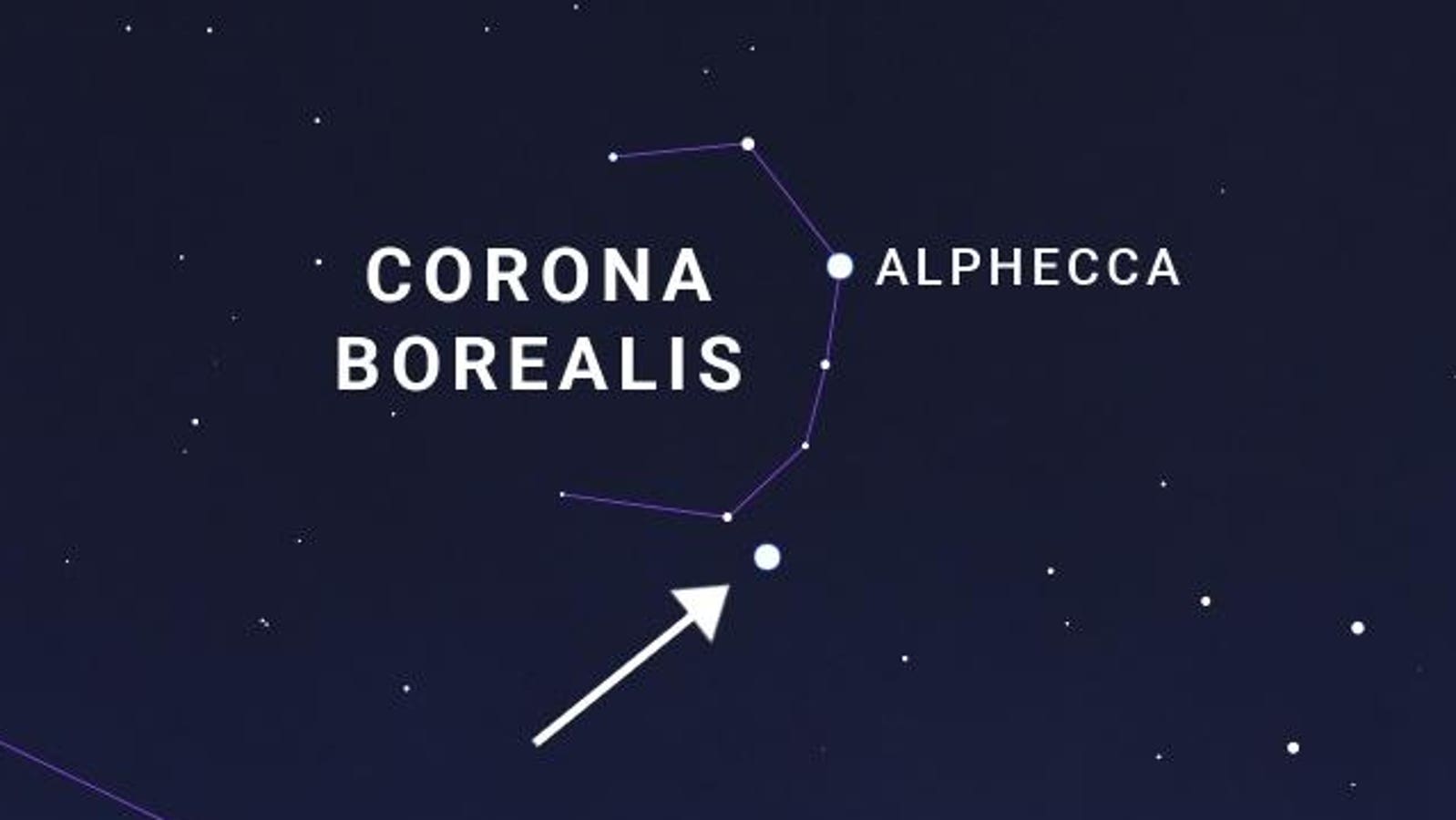Topline
In the wake of 2024’s total solar eclipse and rare displays of the Northern Lights, a third once-in-a-lifetime sight could be possible in 2025 as a star explodes as a nova for the first time since 1946. With T Coronae Borealis (also called T CrB and the “Blaze Star”) due to become 1,000 times brighter than normal and become visible to the naked eye for the first since 1946, NASA is advising sky-watchers to get to know the patch of sky it’s going to appear in.
Sky chart showing constellation Corona Borealis with the location where nova “T CrB” is predicted to … More appear. The view depicts the constellation with the nova occurring, indicated by an arrow.
NASA/JPL-Caltech
Key Facts
T Corona Borealis is a dim star that will briefly become a nova (new star) sometime during 2025, increasing from +10 magnitude, which is invisible to the naked eye, to +2 magnitude, which is about as bright as Polaris, the North Star.
It’s a “cataclysmic variable star” and a “recurrent nova” — a star that brightens dramatically on a known timescale, in this case about 80 years. That last happened in 1946, so it’s due any day now.
Astronomers first predicted T CrB would explode between April and September 2024 after it suddenly dimmed in 2023 — a telltale sign that an explosion is imminent. However, that didn’t happen. It was then predicted by scientists to “go nova” on Thursday, March 27, 2025, but that also failed to happen.
The “Blaze Star” is about 3,000 light-years away from the solar system. When it does finally “go nova,” it will become visible to the naked eye for a few nights.
How To Find T Coronae Borealis (t Crb & ‘the Blaze Star’)
Unless you know where that star is in the night sky, it’s not going to be an impactful event. NASA’s Preston Dyches makes that point in a new blog post published this week — and it includes a valuable sky chart (below) showing everyone where to look.
T Coronae Borealis is a dim star in a constellation called Corona Borealis, “Northern Crown,” a crescent of seven stars easily visible after dark from the Northern Hemisphere. “You’ll find Corona Borealis right in between the two bright stars Arcturus and Vega, and you can use the Big Dipper’s handle to point you to the right part of the sky,” writes Dyches. “Try having a look for it on clear, dark nights before the nova, so you’ll have a comparison when a new star suddenly becomes visible there.”
He advises practicing finding Corona Borealis in the eastern part of the sky during the first half of the night after dark during May, “so you have a point of comparison when the T CrB nova appears there.””
A sky chart indicating how to locate the constellation Corona Borealis between the bright stars … More Arcturus and Vega. The Big Dipper’s handle points in the direction of Corona Borealis.
NASA/JPL-Caltech
The Science Behind The Nova
T Coronae Borealis is a binary star system that consists of two stars at the end of their lives: a white dwarf star that’s exhausted its fuel and is cooling down and a red giant star that’s cooling and expanding as it ages, expelling hydrogen as it does.
That material is gathering on the surface of the white dwarf. When it reaches a critical point, it triggers a thermonuclear explosion that causes a sudden and dramatic increase in brightness. The explosion only affects its surface, leaving the white dwarf intact, so the whole process can occur again and again, according to NASA.
Further ReadingForbesSoviet Probe May Strike Earth Next Wednesday — What To KnowBy Jamie CarterForbesWhat To See In The Night Sky In May 2025: A Comet, Meteors And A ‘Flower Moon’By Jamie CarterForbesWhen To See ‘Shooting Stars’ From Halley’s Comet On Monday And TuesdayBy Jamie Carter
